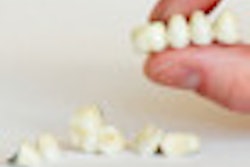
They kill human cells on contact. They cause allergies. They mimic female hormones. And as more and more people keep using them, a health crisis may loom.
That's the dire assessment on resin-based composite filling materials, courtesy of Michel Goldberg, D.D.S., Ph.D., an emeritus professor of dental surgery at Paris Descartes University, who published his paper online in the November Clinical Oral Investigations.
"It would be surprising [if] the harmful effects that are well identified in laboratory studies, and reviewed in this paper, have no clinical consequences," Goldberg asserts. "In the [near] future, we might face major problems in terms of public health."
Because they match tooth color -- and because of concerns about the mercury in amalgam -- resin-based composites are becoming the most popular material for restorations. In 2005, roughly half of all fillings in the United States were composite, according to a paper published in the September-October 2007 issue of Public Health Reports. But not enough research has been done to prove they're safe, Goldberg warns.
And he's not the first: "There is very little reliable information with respect to the biological interactions between resin components and various tissues," wrote Werner Geurtsen, a dentistry professor at the University of Hannover, Germany in a 2000 issue of Critical Reviews in Oral Biology & Medicine "It is critical, both for our patients and for the profession, that the biological effects of resin-based filling materials be clarified in the near future."
So should dentists begin ripping out their patients' composite fillings? Hardly, says Karl-Johan M. Sölderholm, D.D.S., Ph.D., professor of materials science and engineering at the University of Florida. The reality is that you have to fill cavities with something and no material is perfect. All things considered, resins are "pretty safe, or at least the frequency of causing problems is pretty low," he says.
Four areas concern researchers:
First, is the problem of monomers leaching into the body. Monomers are the small molecules in resins that bond with each other to form hard fillings. Research shows that this hardening process, polymerization, doesn't completely bind these monomers. As much as 5 percent of the monomers, such as triethylene glycol methacrylate (TEGDMA) and 2-hydroxy-ethyl-methacrylate (HEMA), remain free to leach out into the surrounding tissue. Although this problem has been minimized thanks to recent innovations, it hasn't been eliminated, Dr. Goldberg writes. And over time, reaction with saliva releases more of these compounds.
In laboratory experiments, these monomers have been shown to kill human cells, including pulp and gingival fibroblasts, the cells most likely to come in contact with them. TEGDMA and HEMA appear to inhibit the cells' ability to create proteins that are key to their survival. And there is some evidence that these monomers foster tumor growth, Dr. Goldberg writes. He adds that the effects could be severe if the restoration comes in direct contact with the pulp.
There is some evidence that the monomers do kill gum tissue: teeth with this type of filling on average have greater-than-normal pocket depths around them than unrestored teeth do, says Rodway Mackert, D.M.D., Ph.D., a professor at the Medical College of Georgia’s School of Dentistry and a spokesman for the American Dental Association (ADA). But the effect is a small one, and human beings can afford to lose a cell here and there, he says. "Most people don't think it's a cause for much concern."
The second concern is allergic reactions. Even when these monomers don't kill cells directly, they have been reported to cause dermatitis and even bronchospasm. These allergic reactions affect a minority of people -- somewhere between 0.7 percent and 2.0 percent of patients and practitioners, according to research Dr. Goldberg cites.
Third, there are concerns about estrogen-like effects of resin materials. One study found that bisphenol A, another resin component, given to female mice reduced their pregnancies by half. But the amounts leaching out of fillings may not be enough to affect humans; most people guzzle down far more of these substances from the linings of canned foods, says Dr. Sölderholm. In sum, he says, dental materials aren't going to contribute much to your overall exposure.
Finally, despite improvements in recent years, resin-based composites still shrink a bit as they solidify, leaving cracks between them and the tooth structure that bacteria can slip through. And monomers appear to encourage bacterial growth. Dr. Goldberg writes that cavities forming underneath composite may be the biggest reason why 200 million fillings have to be replaced in the United States each year.
In an e-mail to DrBicuspid.com, he estimates that radiology and "clinical testing" had shown problems with 2.5 percent of resin composite fillings, and he called for research to discover whether monomers are killing pulp in other teeth as well. Typically this happens without causing pain, so patients may be unaware of the damage, he warns.
Dr. Sölderholm doesn't dispute that composite resins can cause problems, and he agrees that more research is called for. But in the meantime, he argues, dentists should go on using composite because there are problems with all the alternatives. Glass ionomer is more fragile. Gold is more expensive and less esthetic. Silver amalgam is also less attractive and contains mercury which, even if it doesn't harm the patient or the practitioner, can pollute the environment. "Nothing is really safe," he says. "You have to compare it to the risks of real life. Catching a plane or even crossing the street may be more dangerous."



















